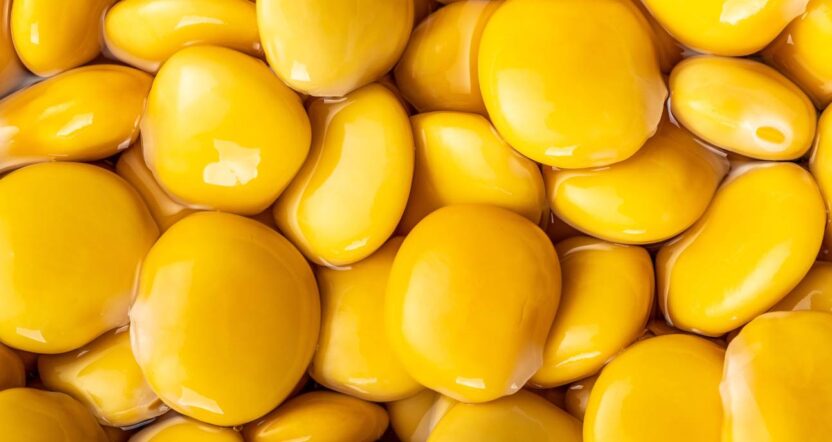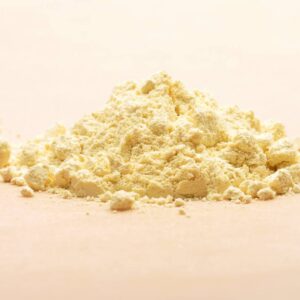Lupin beans stand out among legumes due to their high protein and low carbohydrate content. This article provides an in-depth look at the nutritional benefits, potential drawbacks, and various ways to use lupin beans.
What Are Lupin Beans?
Lupin beans come from plants in the Lupinus genus. These small, yellow legumes have been part of human diets since ancient times, with evidence suggesting cultivation as far back as 2000 BC by the Ancient Egyptians and Romans. Unlike other legumes, lupin beans contain significantly more protein and fewer carbohydrates, with almost no starch. They are also a rich source of fibre.
Sweet Lupins vs. Bitter Lupins
Lupin beans come in different varieties, mainly sweet and bitter. Bitter lupins contain mildly poisonous quinolizidine alkaloids, such as lupanine, lupinine, and sparteine, and mainly grow on the Lupinus albus plant in the Mediterranean region. Sweet lupins, grown in Australia, come from a domesticated version of the Lupus angustifolius plant.
Bitter lupins can be eaten if soaked in salted water to remove the alkaloids and eliminate their bitter flavour. However, about 80% of commercial lupin bean production comes from Australia and focuses on sweet lupin beans.
Key Point: Lupin beans are high in protein and fibre and have been part of human diets for thousands of years.
Nutrition Facts
A one-cup (166 grams) serving of cooked lupin beans contains the following nutritional values:
| Name | Amount | % Daily Value |
|---|---|---|
| Calories | 198 kcal | 10% |
| Carbohydrate | 16.4 g | 5% |
| Fiber | 4.65 g | 17% |
| Fat | 4.85 g | 6% |
| Protein | 25.85 g | 52% |
Vitamins and Minerals
Lupin beans are rich in vitamins and minerals. A 166-gram serving provides:
Vitamins
Folate: 97.94 mcg (25% DV)
Thiamin (B1): 0.22 mg (18% DV)
Vitamin K: 12.12 mcg (10% DV)
Choline: 51.29 mg (9% DV)
Minerals
Manganese: 1.12 mg (49% DV)
Copper: 19.2 mg (43% DV)
Magnesium: 89.64 mg (21% DV)
Zinc: 2.29 mg (18% DV)
Phosphorus: 212.48 mg (17% DV)
Iron: 1.99 mg (11% DV)
Potassium: 406.71 mg (9% DV)
Selenium: 4.32 mcg (8% DV)
Calcium: 84.66 mg (7% DV)
Sodium: 6.64 mg (0.2% DV)
Lupin beans also contain phytonutrients, including flavonoids and phenolic acids like apigenin, caffeic acid, and gallic acid.
Key Point: Lupin beans are low in fat, high in protein, and contain a good range of nutrients.
Lupin Beans Are Lower in Calories Than Other Legumes
Lupin beans have a low carbohydrate and calorie content due to their minimal starch. A cup of lupin beans contains 198 calories, compared to 296 calories in soybeans and 294 calories in adzuki beans.
Excellent Source of Protein
Lupin beans are a high-protein legume, with nearly 26 grams of protein per cup. Studies suggest that lupin protein may positively affect cardiovascular health. For example, a study showed that patients taking a lupin protein supplement experienced a 4% reduction in LDL cholesterol levels over 28 days.
Key Point: Lupin beans are among the best plant-based sources of protein, potentially improving cardiovascular health markers.
Lupin Beans Have a Low Glycemic Index
Lupin beans have a low glycemic index due to their small amount of carbohydrates and high fibre content. Research indicates that adding lupin flour to foods like white bread can significantly reduce the glycemic index of the final product.
Key Point: Lupin beans have a low glycemic index due to their high protein and fibre content.
Potential Drawbacks
Improper Preparation of Bitter Lupins (Lupin Poisoning)
Bitter lupin beans contain toxic quinolizidine alkaloids. Improper soaking to reduce alkaloid content can lead to neurological, digestive, and cardiovascular effects. However, such intoxication is rare with commercially prepared pickled lupins.
Allergies
Lupin bean allergy is a concern due to its belonging to the same family as peanuts. Studies have shown cross-reactivity rates between peanut and lupin allergies.
Key Point: Potential concerns include the consumption of improperly prepared bitter lupins and the risk of allergy.
How To Use Lupin Beans
Lupin beans can be used in various forms:
Whole Lupin Beans: Can be added to curries, stews, or salads.
Pickled Lupin Beans: Preserved in salted water and eaten as a snack.
Lupin Flour: A low-carb, protein and fibre-rich flour for baking.
Final Thoughts
Lupin beans are a nutritious food, providing a good source of protein and fewer carbohydrates and calories than most other legumes. Concerns about bitter lupins can be avoided by choosing sweet lupin beans.






